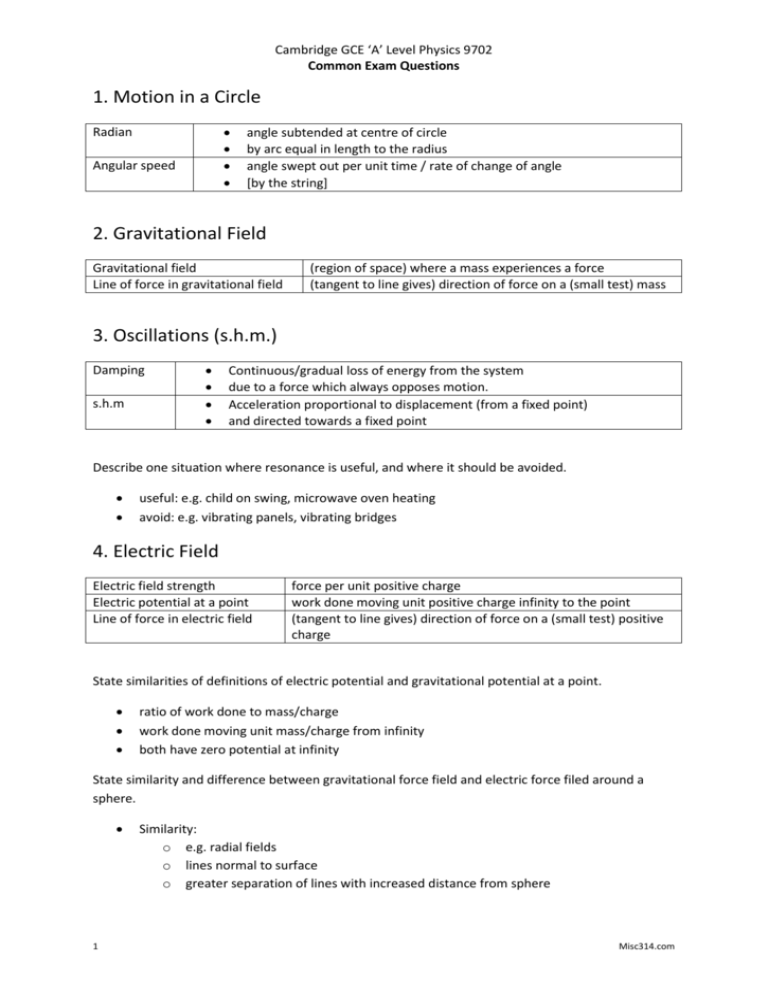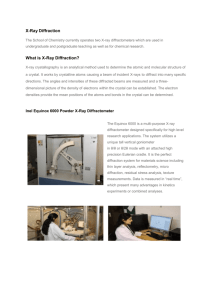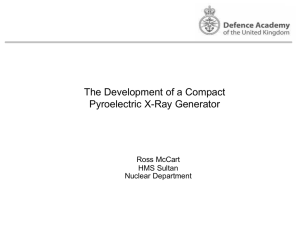Cambridge GCE `A` Level Physics 9702 Common Exam Questions 1
advertisement

Cambridge GCE ‘A’ Level Physics 9702 Common Exam Questions 1. Motion in a Circle Radian Angular speed angle subtended at centre of circle by arc equal in length to the radius angle swept out per unit time / rate of change of angle [by the string] 2. Gravitational Field Gravitational field Line of force in gravitational field (region of space) where a mass experiences a force (tangent to line gives) direction of force on a (small test) mass 3. Oscillations (s.h.m.) Damping s.h.m Continuous/gradual loss of energy from the system due to a force which always opposes motion. Acceleration proportional to displacement (from a fixed point) and directed towards a fixed point Describe one situation where resonance is useful, and where it should be avoided. useful: e.g. child on swing, microwave oven heating avoid: e.g. vibrating panels, vibrating bridges 4. Electric Field Electric field strength Electric potential at a point Line of force in electric field force per unit positive charge work done moving unit positive charge infinity to the point (tangent to line gives) direction of force on a (small test) positive charge State similarities of definitions of electric potential and gravitational potential at a point. ratio of work done to mass/charge work done moving unit mass/charge from infinity both have zero potential at infinity State similarity and difference between gravitational force field and electric force filed around a sphere. 1 Similarity: o e.g. radial fields o lines normal to surface o greater separation of lines with increased distance from sphere Misc314.com o 𝑓𝑖𝑒𝑙𝑑 𝑠𝑡𝑟𝑒𝑛𝑔𝑡ℎ ∝ 1 (𝑑𝑖𝑠𝑡𝑎𝑛𝑐𝑒 𝑡𝑜 𝑐𝑒𝑛𝑡𝑟𝑒 𝑜𝑓 𝑠𝑝ℎ𝑒𝑟𝑒)2 Difference: o e.g. gravitational force (always) towards sphere o electric force direction depends on sign of charge on sphere / towards or away from sphere o gravitational field/force is attractive o electric field/force is attractive or repulsive Explain why values of gravitational potential are always negative whereas values of electric potential may be positive or negative. gravitational forces are (always attractive) electric forces can be attractive or repulsive for gravitational, work got out as masses come together/mass moves from infinity for electric, work done on charges if same sign, work got out if opposite sign as charges come together State the relationship between electric field strength E and potential V. field strength = potential gradient 𝐸 = −∆𝑉 or electric field is in direction of decreasing potential field ∆𝑥 5. Capacitance Capacitance Q/V, with symbols explained Functions of capacitors in electrical circuits e.g. storing energy separating charge blocking d.c. producing electrical oscillations tuning circuits smoothing preventing sparks timing circuits Briefly explain how a capacitor stores charges energy. on a capacitor, there is charge separation/there are + and - charges either to separate charges, work must be done or energy released when charges ‘come together’ 7. Electromagnetism 2 Misc314.com 8. Electromagnetic Induction Faraday’s law of electromagnetic induction Magnetic flux density Tesla (Induced) e.m.f./voltage is proportional/equal to rate of change of (magnetic) flux (linkage) (numerically equal to) force per unit length on straight conductor carrying unit current normal to the field (long) straight conductor carrying current of 1 A current/wire normal to magnetic field (for flux density 1 T,) force per unit length is 1 Nm–1 Explain why eddy currents are induced in a metal disc swinging between poles of magnet. field in disc is not uniform/rate of cutting not same/speed of disc not same (over whole disc) so different e.m.f.’s in different parts of disc lead to eddy currents Use energy principles to explain why the disc comes to rest after a few oscillations. eddy currents dissipate thermal energy in disc energy derived from oscillation of disc energy of disc depends on amplitude of oscillations 9. Alternating Current R.m.s. value of a.c. (in terms of heating effect) the (value of the) direct current that dissipates (heat) energy at the same rate (in a resistor) 10. Temperature Adv of thermocouple thermometer > resistance thermometer small thermal capacity/measure ∆θ of small object /short response time readings taken at a point/physically small can be used to measure temperature difference no power supply required 11. Thermal Properties of Matter Specific latent heat of fusion 3 (thermal) energy/heat required to convert unit mass of solid to liquid with no change in temperature Misc314.com Use the kinetic theory of matter to explain why melting required energy but there is no change in temperature. (on melting,) bonds between molecules are broken/weakened or molecules further apart/are able to slide over one another kinetic energy unchanged so no temperature change potential energy increased/changed so energy required 12. Ideal Gas <c2> Ideal gas Mean square speed of atoms/particles/molecules Gas that obeys the law 𝑝𝑉 = constant at all values of p, V and T 𝑇 Explain qualitatively how molecular movement causes the pressure exerted by a gas. molecule(s) rebound from wall of vessel / hits walls change in momentum gives rise to impulse / force either (many impulses) averaged to give constant force / pressure or the molecules are in random motion 13. Charged Particles State a fundamental property of charge that was suggested by Millikan oil-drop experiment. charge is quantised / discrete quantities Explain why the path of proton in a magnetic field is an arc of a circle. force on proton is normal to velocity and field provides centripetal force (for circular motion) 14. Quantum Physics Photon Work function at the metal surface De Broglie wavelength Quantum/packet of energy of electromagnetic radiation/energy energy of photon to cause emission of electron from surface with zero k.e wavelength of wave associated with a particle that is moving Explain why most electrons are emitted with EK less than maximum in photoelectric effect. max. k.e. corresponds to electron emitted from surface energy is required to bring electron to surface 15. Nuclear Physics 4 Misc314.com Decay constant Binding energy of a nucleus Probability of decay per unit time Energy required to completely separate the nucleons in a nucleus 16. Direct Sensing State three characteristics of an ideal operational amplifier (op-amp). infinite (voltage) gain infinite input impedance zero output impedance infinite bandwidth infinite slew rate 17. Remote Sensing 17.1 X-ray Sharpness Contrast ease with which edges of structures can be seen difference in blackening between structures Outline the principles of production of X-rays in an X-ray tube. The detailed structure and operation of an X-ray tube are not required. Electrons are emitted by thermionic emission at the hot metal filament (cathode) and are accelerated to high speeds towards the metal (anode) target. When high speed electrons bombard/hit the metal target, they are decelerated greatly and gives off e.m. radiation (in the x-ray region). The wide range of deceleration (Bremsstrahlung radiation) gives a continuous spectrum with a short cut-off wavelength. Some electrons in the target atoms are excited and the de-excitation of these electrons gives rise to a line spectrum / characteristic peaks. Explain the principles behind the use of X-rays for imaging body structures. 5 The x-ray beam (from the x-ray) tube is directed through the body onto a photographic film/detector plate (placed behind the body). As the x-ray beam passes through the body, different tissues absorb/attenuate the beam by different amounts e.g. bone absorbs or attenuates x-rays much more than soft tissues/fats. This produces ‘shadow’ image of the internal structures. The sharpness of image can be improved by decreasing the area of the target anode / the size of the aperture / placing a lead grid in front of the photographic film/detector to absorb the scattered x-ray photons. The contrast of the image can be improved by using a contrast medium (e.g. barium sulphate) which absorbs x-rays strongly. Misc314.com Principles of CT scanning The machine (x-ray source and detector) rotates around the patient’s body. A series of x-ray images of a slice through the body is taken from different angles. Then the data of each individual x-ray image and angle of viewing is entered into a powerful computer which combines the images into an image of a slice through the structure. The patient is moved slightly forward so an image of another slice is made. This is repeated for many slices. The images of a series of slices are combined to build or form a complete 3D image of the whole object which can then be rotated or viewed from any angle. A powerful computer is needed to store, process and combine the huge quantity of data. Describe how the image produced during CT scanning differs from that produced by X-ray imaging. X-ray image is flat OR 2-dimensional CT scan takes many images of a slice at different angles these build up an image of a slice through the body series of images of slices is made so that 3D image can be built up 17.3 Ultrasound Acoustic impedance product of density (of medium) and speed of sound (in medium) Briefly explain the principles of the generation of ultrasound. When a potential difference is applied across the silver-coated sides of a piezoelectric crystal e.g. quartz, it causes the crystal to change shape. So when an alternating voltage is applied, it causes the crystal to vibrate. When the frequency of the applied alternating voltage matches the natural vibration frequency of the crystal, resonance occurs and the crystal produces an intense sound wave. Frequency at which the crystal will resonate can be tuned by selecting its thickness. Dimensions of the crystal are chosen such that it vibrates at frequencies greater than 20kHz, hence producing ultrasonic waves. Explain briefly the use of ultrasound to obtain diagnostic information about internal body structures. Short pulses of ultrasound are produced and transmitted into the body (via a coupling medium i.e. a water-based jelly/gel). These pulses are partly reflected and refracted at boundaries between media in the body. The reflected pulses are detected by the piezoelectric crystal and transformed into voltage pulses which are amplified, processed and displayed on an oscilloscope screen. The time interval/delay (between transmission and reception) of pulse gives information about the depth of the boundary while the intensity of the reflected pulse gives information about the nature of the boundary. Adv of using ultrasound of frequency 1MHz instead of 100 kHz. 6 Misc314.com wavelength at 1 MHz is shorter so greater detail is possible Suggest and explain why ultrasound probe is made up of a number of crystals. crystals are at different orientations signals from all crystals are combined to build up a (2D) image Explain why acoustic impedance is important when considering reflection of ultrasound at the boundary between two media. difference in acoustic impedance determines fraction of incident intensity that is reflected/amount of reflection 17.4 MRI Outline briefly the use of magnetic resonance to obtain diagnostic information about internal body structures. When a large/strong uniform magnetic field is applied, all the hydrogen nuclei in the body are aligned and precess about the direction of the field. When a radio frequency pulse (r.f. pulse) at Larmour frequency is applied, it causes resonance in the nuclei. When the applied r.f. pulse ends, on relaxation, the nuclei de-excite and emit r.f. pulse which is detected by the coil and then sent to the computer to be processed. A non-uniform field that is superimposed on the large uniform magnetic field allows the position for the nuclei to be determined and the location of detection to be changed. Adv of MRI > X-ray e.g. cost, portability of equipment, time taken 18. Telecommunications 18.1 Modulation (AM & FM) Frequency modulation (FM) Amplitude modulation (AM) Modulation 7 frequency of carrier wave varies (in synchrony) with information signal constant amplitude or carrier frequency >> signal frequency change in frequency measures displacement of information signal rate at which carrier frequency varies gives frequency of information signal amplitude of the carrier wave varies in synchrony with the displacement of the information signal variations in either amplitude or frequency of a wave Misc314.com in synchrony with displacement of information signal Adv and disadv of FM > AM Adv: better quality/less interference Disadv: more transmitters/more expensive Why is cost of FM broadcasting to an area is greater than that of AM broadcasting? e.g. more radio stations required / shorter range more complex electronics larger bandwidth required Why are modulated carrier waves used rather than direct transmission of electromagnetic waves having audio frequency? Less attenuation Less distortion Lower transmission power Longer transmission range Allow >1 station in a region Shorter aerial required. 18.2 Digital transmission Outline briefly the principles involved in the analogue-to-digital conversion of the signal and its transmission. signal sampled at regular intervals signal voltage converted to a digital number transmitted as a series of groups of pulses pulses could be IR pulses in optic fibre (allow any sensible example) any other relevant physics (e.g. sample at twice max frequency, use parallel to series converter) Adv of transmission of data in digital form. e.g. can be regenerated to remove noise data can be added to check for/correct errors Effects on society of the change to the transmission of signals in digital form, rather than analogue. 8 E.g. digital more reliable than analogue fewer people employed in telephone industry greater multiplexing means reduced cost per call reduced costs means available to more people huge expansion international calls huge expansion of non-voice communications Misc314.com development/expansion of internet introduction of multichannel cable TV companies Suggest two ways in which the reproduction of the original analogue signal could be improved. sample more frequently greater number of bits 18.3 Channel of communication Fibre-optic transmission of a signal signal is in the form of a series of pulses of light/IR pulses pass along a glass fibre as a result of total internal reflection Technological and social adv of fibre-optic transmission compared to metal cable transmission Tech: e.g. greater bandwidth, less noise, less power loss per unit length Social: e.g. increased security, cheaper, less bulky Adv of co-axial cables or optic fibres over wire pair. e.g. greater bandwidth, less noise, less attenuation Purpose of copper braid in co-axial cable and how the purpose is achieved electromagnetic shielding for the inner conductor the braid is earthed Why does increased bandwidth lead to a reduction in cost of telephone calls? increased bandwidth means more information can be carried so more calls can be transmitted simultaneously fewer links are required Example of use of wire pair in communication system. E.g. link between house and exchange for a telephone 18.4 Satellites Describe the orbit of a geostationary satellite. period (or orbit) is 24 hours equatorial (orbit) (satellite orbits) from west to east Remain at one point above the Earth Suggest why the frequency of transmission from the satellite is different from that received by the satellite from Earth. 9 Misc314.com prevent swamping of the (low power) signal received from Earth Adv and disadv of the use of geostationary satellites when compared with polar-orbiting satellites for telephone communication. e.g. fewer satellites required aerials point is fixed direction/no tracking required e.g. noticeable time delay in messages reception difficult at Poles Suggest one adv of launching satellite from the Equator in the direction of rotation of the Earth. e.g. satellite will already have some speed in the correct direction 18.5 Signal Attenuation Attenuation Noise Cross-talk loss of energy/power (in the signal) unwanted (random) signal picking up of signal in one cable from a second (nearby) cable Sources of attenuation and noise in metal cables Attenuation: thermal energy (in the cable) / resistance Noise: e.g. molecular/lattice vibrations, pick-up of e.m. signals, cross-talk/cross-linking 18.6 Mobile network Explain how reception of signals to and from the mobile phone is maintained during a phone call whilst moving through several different cells. computer at cellular exchange monitors signal strength switches call from one base station to another to maintain maximum signal strength Outline what happens at the base station and the cellular exchange when a mobile phone handset is switched on, before a call is made. handset sends out an (identifying) signal communicated by base stations to (computer at) exchange computer selects base station with strongest signal and allocates a (carrier) frequency Suggest and explain why a country is divided into a number of cells. 10 carrier frequencies can be re-used (simultaneously without interference) so that number of handsets possible is increased Misc314.com


